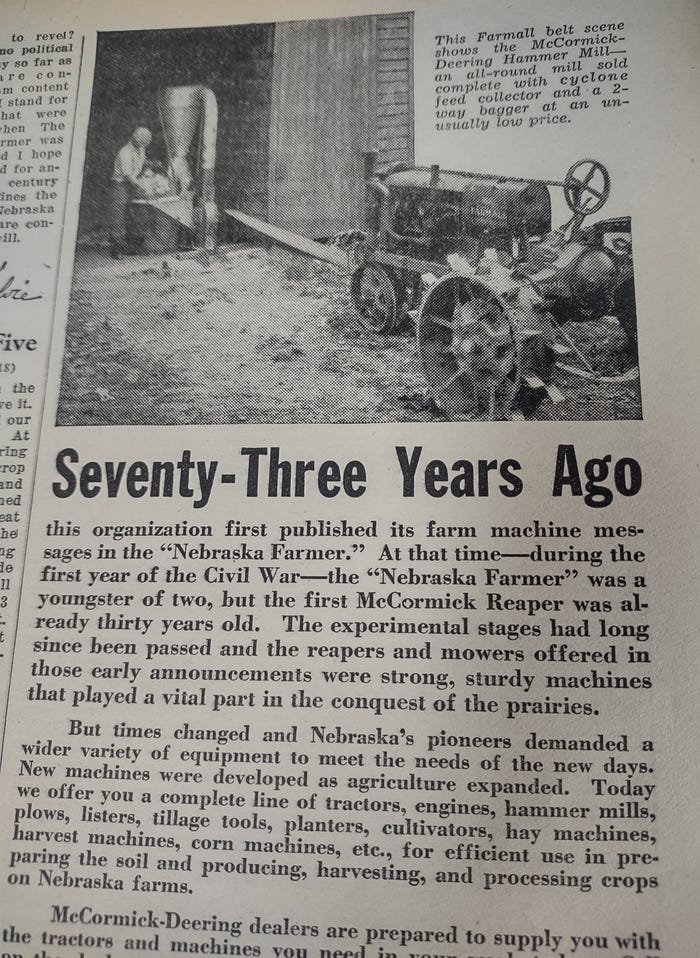Then and Now: An ad in a 1934 Nebraska Farmer magazine touts the “new” concepts and technological advances of the Farmall brand.
January 24, 2023
If you watched the Dec. 31 episode of This Week in Agribusiness, you saw host Max Armstrong interview representatives and executives with Case IH about the celebration taking place around the 100th anniversary of the Farmall brand.
That’s why it was interesting for us to look back to the Dec. 8, 1934, issue of Nebraska Farmer, where we found on Page 19 an ad for McCormick-Deering “Farm-Operating Equipment,” featuring a Farmall F-20 tractor belt-driving a McCormick-Deering hammer mill.
The ad, paid for by International Harvester Co., touts branch stores serving Nebraska in Grand Island, Lincoln, Omaha, Cheyenne, Wyo., St. Joseph, Mo., and Sioux City, Iowa. At the bottom of the ad is a photo of a McCormick-Deering Farmall and four-row lister cultivator in the field.
Many farmers working today grew up driving one Farmall tractor or another. For many, it was an H or M, painted bright Farmall Red. For past generations, it might have been a Regular or F-20. For others, it was a 560, 806, 1256 or 1568. Farmalls have been around for what seems like forever.
In fact, the 5 millionth Farmall tractor came off the Farmall Works plant in Rock Island, Ill., at 9 a.m. Feb. 1, 1974, making IHC the first tractor manufacturer to reach that production milestone. Farmall plates would continue on new 1974 and 1975 models until the old plates were gone, but the company officially dropped “Farmall” from new tractor models in 1973. That would be until Case IH reintroduced the Farmall brand in utility tractors beginning in 2004.

OLD AD: This ad in the Dec. 8, 1934, issue of Nebraska Farmer shows the versatility of the Farmall brand of tractors. (Farm Progress)
If you look back at the history of the brand, you’ll see that early engineers weren’t convinced that the brand would ever take off. Engineers evolved the concept of the old motor cultivator into a tractor they wanted to completely replace the team of horses as a truly all-purpose machine.
The newly designed model, called “Farmall,” was different from other mass-produced tractors in that it brought a combination of specialized traits into one tractor and was the first design to do so.
It was a tricycle configuration with a single front wheel or narrowly spaced pair of wheels that included high ground clearance for cultivating; was light in weight with power for belt pulley work, plowing or other tillage; was affordable; and had an easily adjusted axle track.
However, this configuration produced a rather odd-looking tractor for the day. So, when it was first introduced in 1924, it was only introduced in Texas, to minimize any potential negative feedback from early customers. To the surprise of some, the new all-purpose machine was a hit, and large-scale production began at a new Farmall Works plant in Rock Island in 1926.
From 1924 until 1963, Farmalls were the biggest sellers among row crop tractors. The Farmall H, produced from 1939 until 1954, was the all-time No. 2-selling tractor in North America, with only the Ford 8N selling more units.
No matter if it was a Farmall Cub, which was the longest producing line in the Farmall brand, from 1947 until 1979; a Regular or F-20; a Super M or 450; a 560, 706, 1066 or 1568, the Farmalls are still out in the field today doing good work around the country.
The brand itself may be a century old, but as the Nebraska Farmer ad in 1934 touted, it continued to evolve and adapt to the needs of farmers over the years as technology continued to march on.
Curt Arens
Editor, Nebraska Farmer
Curt Arens began writing about Nebraska’s farm families when he was in high school. Before joining Farm Progress as a field editor in April 2010, he had worked as a freelance farm writer for 27 years, first for newspapers and then for farm magazines, including Nebraska Farmer.
His real full-time career, however, during that same period was farming his family’s fourth generation land in northeast Nebraska. He also operated his Christmas tree farm and grew black oil sunflowers for wild birdseed. Curt continues to raise corn, soybeans and alfalfa and runs a cow-calf herd.
Curt and his wife Donna have four children, Lauren, Taylor, Zachary and Benjamin. They are active in their church and St. Rose School in Crofton, where Donna teaches and their children attend classes.
Previously, the 1986 University of Nebraska animal science graduate wrote a weekly rural life column, developed a farm radio program and wrote books about farm direct marketing and farmers markets. He received media honors from the Nebraska Forest Service, Center for Rural Affairs and Northeast Nebraska Experimental Farm Association.
He wrote about the spiritual side of farming in his 2008 book, “Down to Earth: Celebrating a Blessed Life on the Land,” garnering a Catholic Press Association award.
You May Also Like
Ag-related tech from CES
Why future corn rows may be narrower
Questions save lives
Jan 27, 2023
Jan 27, 2023
Jan 27, 2023
Friday’s session leaves grain prices mixed
Scott announces Ag Committee Democrats
A farm show is more than just a farm show
Agriculture needs sustainable intensification
Copyright © 2023. All rights reserved. Informa Markets, a trading division of Informa PLC.



